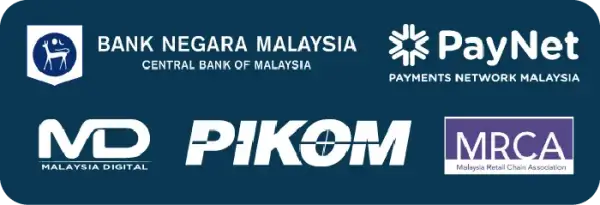
In Malaysia, merchants are facing changing expectations from consumers, rapid innovation in payment tech, and tighter regulatory oversight. As we move through 2025, payment terminals in Malaysia are no longer just card readers, they are hubs of trust, speed, and convenience. This guide explains what’s new, what rules apply, and how merchants can assess cost vs return when upgrading or choosing payment terminals.
What New Terminal Technologies Are Gaining Traction
Contactless / NFC / Tap & Go
- Widely used to enable “tap to pay” via cards or mobile wallets. Faster checkout, no physical contact.
- Supported by many terminals now. Makes sense in retail, F&B, quick‑service outlets.
Mobile POS (mPOS)
- These are smaller, often smartphone‑based or tablet‑based devices, or even dongles, used anywhere. Great for pop‑ups, delivery, street vendors.
- Can reduce fixed terminal cost, allow more flexibility.
QR Code Payments
- QR payments are growing (e-wallets, government, fintech). Some customers prefer QR because no physical card is involved.
- Interoperable QR systems (if available) help.
Hybrid or Smart Terminals
- Devices that support all of the above: card swipe/chip + NFC + QR + wireless connectivity.
- Also terminals with built‑in printing, barcode scanning, etc.
Regulations, Security, and Maintenance Requirements
Merchants in Malaysia must comply with national laws, banking guidelines, and international security standards when handling in-store payment devices. This covers data protection, hardware security, regular upkeep, and measures to prevent fraud.
Key Regulations Governing Card Payment Systems in Malaysia
1. Bank Negara Malaysia (BNM) Oversight
BNM is the main regulator of Malaysia’s financial system, including payment acceptance infrastructure. It governs terminal operations via:
- Payment and Settlement Systems Act 2003: Legal foundation for secure and efficient payment systems.
- Risk Management in Technology (RMiT): Mandatory for financial institutions and service providers offering terminal solutions. Covers cybersecurity, vendor risk, system uptime, and disaster recovery.
- The ‘Technology Requirements for Payment Service Regulatees (2024 Draft)‘ is a proposal that, if implemented, would set out technical and risk management expectations. The final timeline for compliance has not been officially confirmed.
Example: A terminal vendor who fails to implement proper encryption protocols or uses unsecured servers to process transaction data could face sanctions under these frameworks.
2. Personal Data Protection Act (PDPA) 2010
This act applies to all businesses that collect, process, or store customer information. Any in-store payment systems that handle sensitive details (such as customer names or card numbers) must comply with PDPA requirements.
Merchants must ensure customer data is:
- Collected with consent
- Stored securely
- Not shared or leaked without permission
What Are the Security Standards?
1. PCI DSS Compliance
The Payment Card Industry Data Security Standard (PCI DSS) is globally recognised and often required by banks and acquirers. It mandates:
- Encryption of data at rest and in transit
- Secure storage of cardholder data
- Tokenisation to replace sensitive data with non-sensitive equivalents
- Access controls, audit logs, and password policies
Merchants should only use terminals that are PCI-certified, and regularly update their firmware to maintain compliance.
2. Security for Contactless / NFC Transactions
Contactless payments like NFC, Tap to Pay must follow these standards:
- Use of EMV-compliant secure elements
- Short-range transmission to prevent interception
- Device authentication between terminal and card/mobile wallet
- Limits on transaction size without PIN to reduce fraud risk
3. Physical Security Controls
- Terminals must not be exposed to tampering.
- POS staff should be trained to spot suspicious behaviour (card skimming attempts).
- Daily checks of physical terminals for signs of intrusion or damage should be routine.
What Maintenance and Risk Controls Should Merchants Have in Place?
1. Software and Firmware Updates
In-store payment devices rely on embedded software that must be kept up to date:
- Firmware updates close security loopholes
- Outdated equipment risks compatibility issues with banks and payment networks
- Many providers now offer cloud-based updates or remote patching to simplify this process
2. Transaction Monitoring and Fraud Detection
- Acquirers often offer real-time fraud monitoring tools, merchants should enable these
- Merchants can flag and review:
- Multiple failed payment attempts
- Sudden spikes in transaction volume
- Unusual transaction times (late night)
3. Terminal Health and Support
- Merchants should routinely test terminals for:
- Receipt printer jams
- Connectivity drops (WiFi/data failure)
- Slow or failed transaction processing
- Maintain logs of outages or system issues to share with vendors or banks if needed
- Ensure vendor SLA includes fast turnaround for repairs or replacements
Summary Table: Regulatory & Security Checklist for Malaysian Merchants
Area | Key Requirement | Merchant Action |
BNM Oversight | Comply with RMiT, Payment Systems Act | Work with approved vendors, ask for compliance documentation |
PDPA | Protect consumer data | Don’t store sensitive data locally, ensure terminal is secure |
PCI DSS | Secure card data | Use certified terminals, encrypt and tokenise data |
NFC/Contactless | Limit risk of interception or skimming | Set low no-PIN limits, verify device certification |
Maintenance | Update firmware/software regularly | Schedule updates, ensure terminal support from vendor |
Fraud Monitoring | Spot unusual patterns | Enable acquirer monitoring tools, review transaction reports weekly |
The Costs and ROI of Physical Payment Devices for Merchants
Cost Element | What Merchants Pay For | Potential Returns / Savings |
Upfront cost / Lease | Purchase of terminal hardware or leasing/contract cost. More advanced “smart” terminals are costlier. | Enables accepting more payment types which will increase sales and improve customer satisfaction. |
Transaction / Service Fees | Merchant discount rates, fees per transaction, possible monthly service / rental. | With enough volume, fees are a small % of revenue, cheaper per‑transaction costs possible with better contracts. |
Maintenance & Operational Costs | Maintenance, repairs, software/firmware updates, connectivity (internet/WiFi/data), electricity, staff training. | Well‑maintained terminals reduce downtime, fraud, disputes. |
Regulatory / Compliance Costs | Security audits, compliance with BNM / PDPA etc., cost to implement strong encryption or secure infrastructure. | Reduced risk of penalties, trust of customers, less fraud losses. |
Opportunity Costs | If the terminal has slow/limited features, it could lose customers, if payment methods are missing (no QR, no NFC), customers may walk away. | Better technology gives competitive edge, mobile POS or multi‑method acceptance may open new markets. |
Disclaimer: These following are simplified, illustrative examples only. Actual results may vary based on individual business circumstances.
Example ROI Scenarios
- Small Retail Store: A small boutique processing RM30,000/month in card/NFC payments pays roughly RM600 in transaction fees (assuming a 2% rate). If the smart terminal costs RM4,000, the business would recoup the upfront cost in about 6-7 months from the potential increase in sales and operational savings.
- Food Stall: A street food stall opts for a mobile Point-of-Sale (POS) system with a lower upfront cost of RM500. With monthly card sales of RM5,000, the transaction fees would be around RM100. The break-even on the hardware would be just a few months, with additional profit coming from capturing sales from customers who don’t carry cash.
Businesses can now significantly reduce their digital transformation costs with the MSME Digital Grant MADANI. This initiative is designed to support you in adopting new technologies and streamlining your operations.
Key Considerations Before Upgrading / Adopting New Terminals
- What payment methods are being demanded by your customers? (debit/credit card, contactless (NFC), e-wallets (DuitNow QR) or instalment option).
- Volume of transactions: small number of transactions vs many small ones → fee structure matters.
- Reliability of connectivity if the terminal needs online access (mobile data, Wi-Fi, ethernet dock, battery life, fast charging).
- Vendor support & warranty, whether the vendor is compliant with security/regulatory standards.
- Total cost of ownership: Upfront of device price or by rental
Challenges & Risks (and quick mitigations)
- Fraud (skimming/relay/malware).
Mitigate: sealed devices, daily tamper checks, least-privilege user roles, disable unknown apps, encryption/tokenization, clear refund controls. - Regulatory non-compliance.
Mitigate: use certified hardware/software, keep PCI docs/logs, follow vendor hardening guides, train staff on data handling. - Maintenance downtime.
Mitigate: dual-SIM + Wi-Fi, spare chargers/printer rolls, backup acceptance (static QR/SoftPOS), staged firmware updates. - Cost/fee creep (low-margin pressure).
Mitigate: negotiate tiered MDR, route small tickets to lower-cost rails (QR), review blended effective rate monthly, renegotiate annually.
Conclusion: How Merchants Should Move Forward
To stay competitive in 2026 and future, merchants should audit their current terminals against customer demand (contactless, mobile wallets, QR), bake in regulatory and security requirements from the start, and run a clear cost and benefit analysis that weighs hardware, fees, and maintenance against higher sales and a smoother checkout. Choose the Malaysia terminal providers that support multiple payment types, meet security compliance, and deliver reliable after-sales support.
Disclaimer: All brand names, trademarks, and logos displayed on this website are the intellectual property of their respective owners. Their use herein is solely for identification purposes without written consent or direct affiliation from the respective owner.
Frequently Asked Questions About Modern Payment Terminals in Malaysia
Why is NFC faster than chip or swipe?
NFC is contactless and often requires no PIN for small amounts, so checkout time drops.
What is the legal requirement in Malaysia for terminal security?
Are physical terminals becoming obsolete?
Not yet. For many merchants (retail stores, etc.), physical terminals are still vital, the value is shifting toward more versatile units that support many payment methods.
What is the usual cost of a smart terminal in Malaysia?
Depends on features: basic terminals are cheaper, smart hybrid units cost more. Expect upfront hardware & installation costs + ongoing fees. Gathering quotes from vendors gives more precise numbers.
How do I reduce fraud risk with NFC/contactless payments?
Ensure tokenisation, software updates, set transaction limits (PIN verification when amount above certain threshold), staff training, and choose terminals from trusted vendors.
How long do hardware terminals last?
With good maintenance, usually 5‑7 years, but tech changes may make you want to upgrade sooner for newer features or regulatory compliance.
Recent Posts
Categories
Our Partners :





Paydibs is a leading payment solutions provider committed to simplifying transactions for businesses of all sizes.

